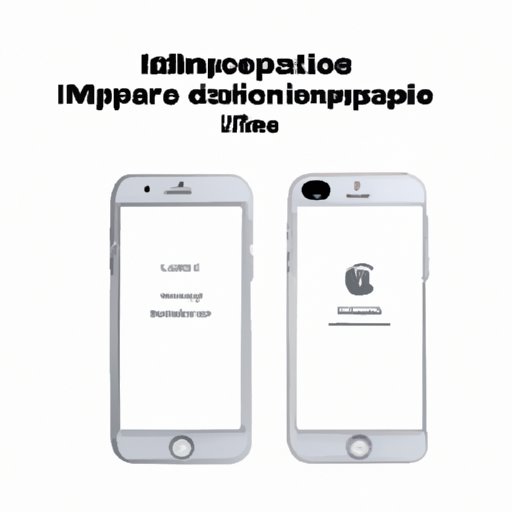
Introduction
Every iPhone user has faced the problem of not knowing what model of iPhone they possess, whether it’s the latest or one that’s several generations old. Not knowing the model can be disconcerting when it comes to purchasing accessories, downloading software, or receiving support. This article will provide users with a friendly, informative guide to identifying their iPhone model and the benefits and drawbacks of each one.
Identifying iPhone Models Based on Physical Characteristics
The easiest way to recognize an iPhone is through its physical characteristics. The shape, design, and specific features can help users determine the model of their phone quickly. For instance, the camera placement, home button, headphone jack, and other elements vary considerably across iPhone models, making identifying the phone easier.
To determine the phone’s model, take note of the placement and type of the iPhone’s button – whether it’s a physical button or a touch-sensitive button. Another thing to look at is the camera lens – does the model feature a dual-lens set up, a square shaped camera housing? Check for the presence or absence of the headphone jack, which can determine the iPhone’s model without knowing the exact specifications.
Illustrating the Most Common iPhone Models
Apple has released multiple iPhone models over the years, each with its unique features and specifications. The most common phone models are iPhone 5, iPhone SE, iPhone 6, iPhone 6S, iPhone 7, iPhone 8, iPhone X, iPhone XS, iPhone XR, iPhone 11, iPhone 12, and iPhone SE 2nd Generation.
Each model has its unique features that can help users identify them. For example, the iPhone 5 has a smaller screen size of 4.0 inches and a headphone jack. The newer iPhone SE has a larger 4.7-inch screen and lacks a headphone jack. The iPhone 6 and 6s series have a circular home button with Touch ID. As for the iPhone 7 and 8, they don’t feature a headphone jack, and instead of a circular button, they have a touch-sensitive button. The iPhone XR, which Apple launched in 2018, has a larger screen size of 6.1 inches, and the latest models such as the iPhone 11 and 12 series feature a camera housing with a square-shaped camera lens.
Identifying iPhone Models by Examining Software and Settings
If a user is unable to identify the model by physical characteristics, inspecting the software and settings of the device can help. Navigate to the “Settings” app on your iPhone and tap on “General,” and then tap on “About.” In the about section, you will be able to find the model name and number, the version of iOS installed on the phone, and other details. Once you have the model number, you can refer to Apple’s website to determine which iPhone model it belongs to.
Another way to find the model number is by checking the phone’s SIM tray. You will need to remove the SIM tray to reveal the model number engraved on it. Once you have the number, you can use a reference guide to determine the exact model.
Troubleshooting Advice for Determining iPhone Models
If a user still cannot identify their iPhone model using the previous methods, there is always the option of reaching out to Apple Support. Support agents can request the device’s unique identifier number, the serial number, to identify the phone model. This method of determining the phone’s model is best if the phone is unable to turn on or is not otherwise accessible.
Insights into the Benefits and Drawbacks of Each iPhone Model
While all iPhones are designed to offer a quality user experience, users may have preferences regarding which model is best for them. Each model offers distinct advantages and disadvantages that might be a deciding factor when choosing your next iPhone. For example, while some models lack a headphone jack, they have larger screens, more significant storage options, and stronger processors. Users should consider their needs and preferences and choose a model that suits them best.
Tips and Tricks for Maintenance and Upkeep
Regardless of which model you have, there are several ways to maintain and keep your phone running smoothly. Regularly backing up the iPhone to iCloud or to a computer can protect a user’s data from being lost. Clearing out apps and data that is no longer needed regularly can help to optimize the device’s performance as it frees up storage space, which prevents the device from slowing down. Installing software updates can also enhance the iPhone’s performance and security.

Advice for Users Considering an Upgrade
Users who are considering an upgrade must determine which model will suit their needs and preferences. While the latest models of iPhones offer cutting-edge features, they may not be necessary, depending on the user’s needs. Users should consider battery life, storage space, camera quality, and other features when determining which model to upgrade to. Users should also consider factors, such as cost and compatibility, before upgrading.
Conclusion
Knowing what iPhone model you have can save time, hassle, and even money. Whether it’s identifying the phone’s physical features or examining the software and settings, users need not fret because there’s always a way to determine the model of their iPhone. While each model has its unique features and benefits, users should consider their needs and preferences when choosing the best model that suits them. By following the tips and recommendations highlighted in this article, users can make informed decisions about their iPhone’s upkeep and upgrade.




